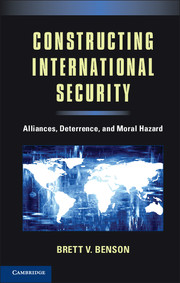Book contents
- Frontmatter
- Contents
- Preface
- Acknowledgments
- 1 Understanding the Design of Security Commitments
- 2 A Typology of Third-Party Commitments
- 3 Time Consistency and Entrapment
- 4 Evidence of Moral Hazard in Military Alliances
- 5 A Theory of Commitment Design
- 6 Testing the Implications for Alliance Design
- 7 Deterrent Commitments in East Asia
- 8 Constructing Security in Today's World
- References
- Index
7 - Deterrent Commitments in East Asia
Published online by Cambridge University Press: 05 November 2012
- Frontmatter
- Contents
- Preface
- Acknowledgments
- 1 Understanding the Design of Security Commitments
- 2 A Typology of Third-Party Commitments
- 3 Time Consistency and Entrapment
- 4 Evidence of Moral Hazard in Military Alliances
- 5 A Theory of Commitment Design
- 6 Testing the Implications for Alliance Design
- 7 Deterrent Commitments in East Asia
- 8 Constructing Security in Today's World
- References
- Index
Summary
This chapter presents a comparative historical analysis of cases of U.S. commitment making in East Asia during the 1950s. The purpose of the analysis is to examine one of the main causal mechanisms in the theory that explains why leaders might select probabilistic deterrence commitments rather than conditional commitment alternatives when trying to balance extended deterrence with ally restraint. The analysis demonstrates that when disputants can take actions in a crisis to initiate or escalate conflict and those actions are hidden from third-party defenders, then a third party intending to ally with one of the disputants will prefer to extend a probabilistic deterrence commitment to its prospective ally. On the other hand, when the disputants' actions are clearly observable to the third party, then, all else being equal, the third party will design a commitment conditional on the disputants’ actions leading to war. The particular cases presented here were selected because they have several features in common, making it possible to hold some factors constant while comparing the observability of disputants’ actions and the third party's choice of commitment type across all cases.
The examination of this historical evidence complements the quantitative tests in Chapters 4 and 6 in several ways. The first contribution of the case studies considered here is that they show the application of the theory to security commitments beyond formal military alliances. In this chapter, I compare Truman's 1950 policy to neutralize the Taiwan Strait, which was not announced as part of a formal military alliance, with three formal military alliances signed by the United States in East Asia between 1950 and 1954. On September 8, 1951, the United States and Japan signed a formal military alliance. The United States and the Republic of Korea (ROK) entered into a mutual defense treaty on October 1, 1953. Then, just a few months later, on December 2, 1954, the United States signed another defensive treaty with the Republic of China (ROC) government on Taiwan.
- Type
- Chapter
- Information
- Constructing International SecurityAlliances, Deterrence, and Moral Hazard, pp. 142 - 168Publisher: Cambridge University PressPrint publication year: 2012



